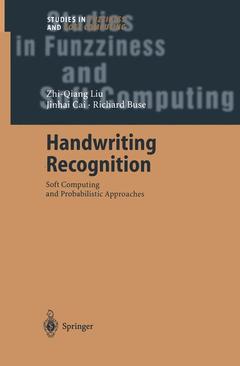Handwriting Recognition, 2003 Soft Computing and Probabilistic Approaches Studies in Fuzziness and Soft Computing Series, Vol. 133
Langue : Anglais
Auteurs : Liu Zhi-Qiang, Cai Jin-Hai, Buse Richard

Over the last few decades, research on handwriting recognition has made impressive progress. The research and development on handwritten word recognition are to a large degree motivated by many application areas, such as automated postal address and code reading, data acquisition in banks, text-voice conversion, security, etc. As the prices of scanners, com puters and handwriting-input devices are falling steadily, we have seen an increased demand for handwriting recognition systems and software pack ages. Some commercial handwriting recognition systems are now available in the market. Current commercial systems have an impressive performance in recognizing machine-printed characters and neatly written texts. For in stance, High-Tech Solutions in Israel has developed several products for container ID recognition, car license plate recognition and package label recognition. Xerox in the U. S. has developed TextBridge for converting hardcopy documents into electronic document files. In spite of the impressive progress, there is still a significant perfor mance gap between the human and the machine in recognizing off-line unconstrained handwritten characters and words. The difficulties encoun tered in recognizing unconstrained handwritings are mainly caused by huge variations in writing styles and the overlapping and the interconnection of neighboring characters. Furthermore, many applications demand very high recognition accuracy and reliability. For example, in the banking sector, although automated teller machines (ATMs) and networked banking sys tems are now widely available, many transactions are still carried out in the form of cheques.
1 Introduction.- 1.1 Feature Extraction Methods.- 1.2 Pattern Recognition Methods.- 2 Pre-processing and Feature Extraction.- 2.1 Pre-processing of Handwritten Images.- 2.2 Feature Extraction from Binarized Images.- 2.3 Feature Extraction Using Gabor Filters.- 2.4 Concluding Remarks.- 3 Hidden Markov Model-Based Method for Recognizing Handwritten Digits.- 3.1 Theory of Hidden Markov Models.- 3.2 Recognizing Handwritten Numerals Using Statistical and Structural Information.- 3.3 Experimental Results.- 3.4 Conclusion.- 4 Markov Models with Spectral Features for Handwritten Numeral Recognition.- 4.1 Related Work Using Contour Information.- 4.2 Fourier Descriptors.- 4.3 Hidden Markov Model in Spectral Space.- 4.4 Experimental Results.- 4.5 Discussion.- 5 Markov Random Field Model for Recognizing Handwritten Digits.- 5.1 Fundamentals of Markov Random Fields.- 5.2 Markov Random Field for Pattern Recognition.- 5.3 Recognition of Handwritten Numerals Using MRF Models.- 5.4 Conclusion.- 6 Markov Random Field Models for Recognizing Handwritten Words.- 6.1 Markov Random Field for Handwritten Word Recognition.- 6.2 Neighborhood Systems and Cliques.- 6.3 Clique Functions.- 6.4 Maximizing the Compatibility with Relaxation Labeling.- 6.5 Design of Weights.- 6.6 Experimental Results.- 6.7 Conclusion.- 7 A Structural and Relational Approach to Handwritten Word Recognition.- 7.1 Introduction.- 7.2 Gabor Parameter Estimation.- 7.3 Feature Extraction.- 7.4 Conditional Rule Generation System.- 7.5 Experimental Results.- 7.6 Conclusion.- 8 Handwritten Word Recognition Using Fuzzy Logic.- 8.1 Introduction.- 8.2 Extraction of Oriented Parts.- 8.3 System Training.- 8.4 Word Recognition.- 8.5 Experimental Results.- 8.6 Conclusion.- 9 Conclusion.- 9.1 Summary and Discussions.- 9.2 Future Directions.- 9.3 References.
A fresh look at the problem of unconstrained handwriting recognition from the soft computing viewpoint
Date de parution : 12-2010
Ouvrage de 230 p.
15.5x23.5 cm
Date de parution : 07-2003
Ouvrage de 230 p.
15.6x23.4 cm
Thème de Handwriting Recognition :
Mots-clés :
Markov; algorithm; algorithms; fuzzy; fuzzy set; hidden markov model; logic; model; learning and instruction; complexity
© 2024 LAVOISIER S.A.S.
